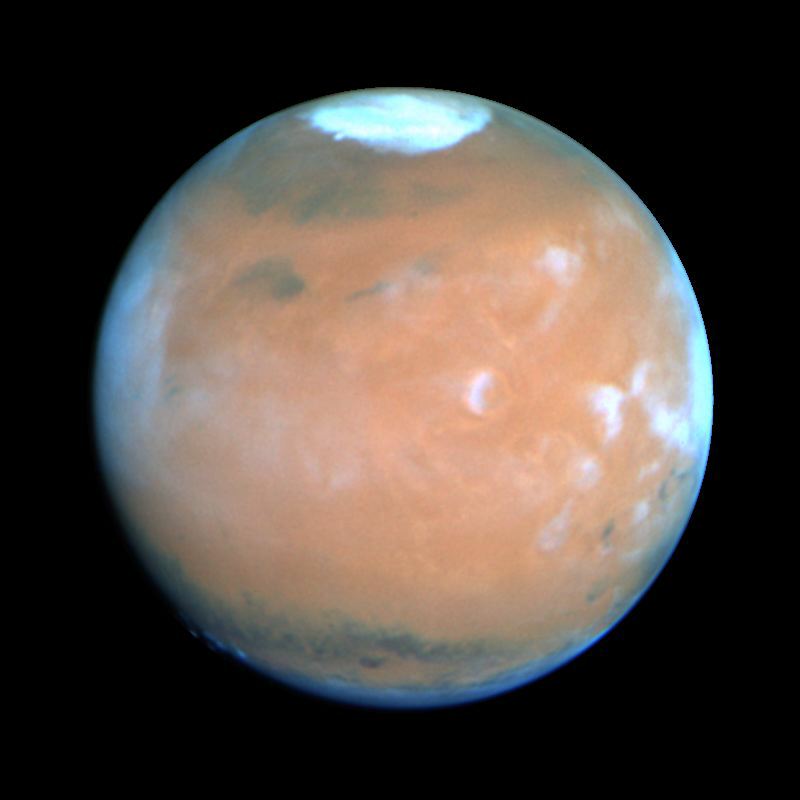The Red Planet is of enormous interest to astrobiologists, as there is considerable evidence that the planet once supported liquid water on its surface, and it is possible that regions of the Martian sub-surface may still be habitable today. Astrobiological research on Mars, led by UWAB faculty and students, focuses on understanding the Martian environment and climate, including the nature and distribution of past habitable environments on Mars.
Mapping Past Liquid Water On Mars
 Evidence that Mars may have had liquid water on its ancient surface can be found in certain geological features that appear to have been eroded by liquid water, such as river valleys that are now dry. UWAB researchers use infrared measurements taken from orbit to identify the locations and duration of extended periods of liquid water on the Martian surface and in the subsurface. Evidence of water-related minerals on Mars indicates that liquid water was present for extended periods of time and that the energy required for such chemical reactions to form these minerals would have also been available for life to utilize.
Evidence that Mars may have had liquid water on its ancient surface can be found in certain geological features that appear to have been eroded by liquid water, such as river valleys that are now dry. UWAB researchers use infrared measurements taken from orbit to identify the locations and duration of extended periods of liquid water on the Martian surface and in the subsurface. Evidence of water-related minerals on Mars indicates that liquid water was present for extended periods of time and that the energy required for such chemical reactions to form these minerals would have also been available for life to utilize.
Using Ice Caps To Probe Mars’ Climate History
 The tilt of the Earth’s rotation axis, or “obliquity”, is stabilized over time by the presence of the Earth’s large Moon. However, Mars has likely suffered frequent, rapid, and large obliquity changes during its history, significantly altering its climate. UWAB researchers combine the study of glaciers and ice sheets on Earth with remote measurements of the Martian ice caps to learn how to read the recent history of Mars’s polar ice — its advances, retreats, and other changes. This reveals how climate variations move ice around the planet, and allows us to better understand Martian habitability through time. These studies also help identify where ice deposits useful for robotic and human exploration of Mars may lie. Other UWAB researchers use temperature data obtained from orbit to characterize near surface water ice deposits near the Martian poles to better understand the current global water cycle.
The tilt of the Earth’s rotation axis, or “obliquity”, is stabilized over time by the presence of the Earth’s large Moon. However, Mars has likely suffered frequent, rapid, and large obliquity changes during its history, significantly altering its climate. UWAB researchers combine the study of glaciers and ice sheets on Earth with remote measurements of the Martian ice caps to learn how to read the recent history of Mars’s polar ice — its advances, retreats, and other changes. This reveals how climate variations move ice around the planet, and allows us to better understand Martian habitability through time. These studies also help identify where ice deposits useful for robotic and human exploration of Mars may lie. Other UWAB researchers use temperature data obtained from orbit to characterize near surface water ice deposits near the Martian poles to better understand the current global water cycle.
Atmospheric Formation Of Perchlorate On Mars
UWAB faculty and students also conduct research looking at geochemical, atmospheric and geological data from spacecraft to try to determine the evolutionary history of the surface and atmosphere of Mars. As an example, UWAB researchers are working to explain the unexpected discovery by the Mars Phoenix Lander of large concentrations of perchlorate (ClO4–) in the Martian soil. Perchlorate tends to absorb water from the atmosphere, forming a solution that has a much lower freezing point than water, allowing for liquid water on Mars at much lower temperatures. On Earth, perchlorate is found in extremely arid areas, and UWAB researchers are using models of chemistry in the Earth’s atmosphere, and field trip work in the Atacama desert, to reveal the atmospheric chemistry that forms perchlorate. These results are incorporated in atmospheric chemistry models of the early Martian atmosphere when Mars was volcanically active and dry. A successful model that explains the Phoenix perchlorate will also help us understand the nature and possible habitability of the early Martian environment.
